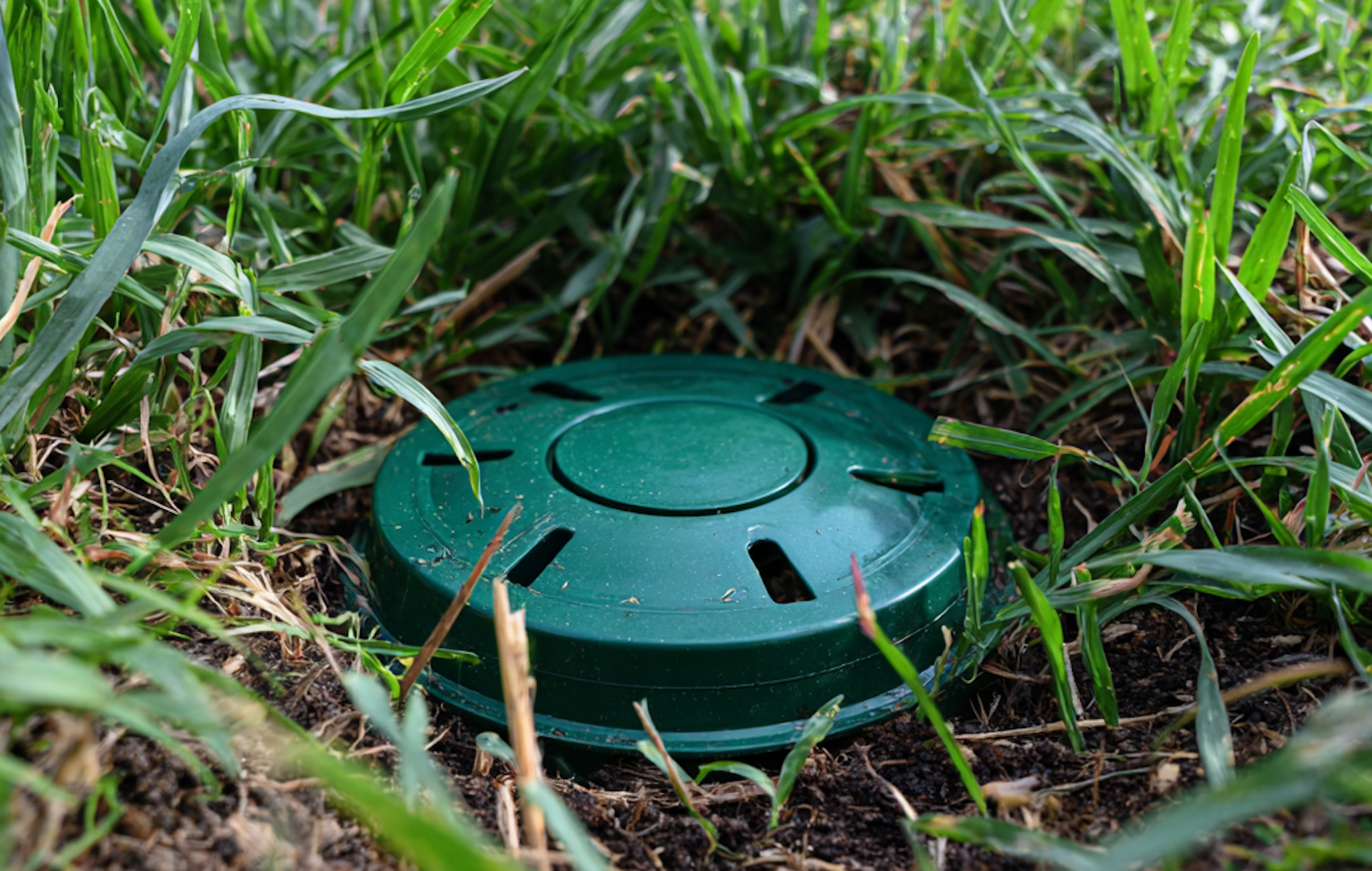Discovering signs of termite activity around your home is never something you can ignore.
These silent destroyers work quickly, and even if the damage isn’t severe yet, it’s only a matter of time before they cause costly structural problems. Acting fast is the only way to protect your property.
In your search for termite solutions, you’ve probably come across termite baiting stations: a widely used and highly effective method for eliminating these wood-hungry pests. But are they the right choice for your home? Can they deliver results in the timeframe you need?
Let’s break down exactly how termite baiting stations work, their pros and cons, and whether they fit your situation best.

What Are Termite Bait Stations?
Termite bait stations are devices installed in the ground around your home. They look like plastic caps that measure no more than a few inches across, with a portion that extends below the surface. Inside is typically a monitoring base and often a changeable bait cartridge.
Termite bait stations are designed to intercept subterranean termites before they reach your home. They’re installed in a spaced-out formation surrounding the property, effectively creating a perimeter to protect it.
Each bait station attracts termites, acting as a checkpoint for any that travel nearby. When termites enter the bait stations, they pick up a slow-acting transmissible poison and carry it back to the colony, where it is consumed.
How Do Termite Bait Stations Work?
Termite bait stations work by attracting termites to a cellulose-based bait laced with a slow-acting insecticide. The termites feed on the bait, carry it back to their colony, and spread it to others, eventually eliminating the entire colony over time.
Bait stations can help eliminate termite queens, workers, and swarmers.
Here’s how they work in practice:
- Installation: A pest management specialist installs the bait stations, or monitoring stations, around the property. They are located within 2-4 feet of the foundation and spread 8-10 feet apart.
- Baiting: Inside each cartridge is a monitoring base that contains food sources that naturally attract termites, along with a slow-acting poison that’s transmitted to them upon entering. This ultra-low disturbance approach allows termites to find and feed without alarm.
- Colony Elimination: The slow-acting poison picked up from the bait is spread to the colony, eliminating the problem at its source.
- Monitoring: Baiting stations are routinely inspected and replenished as necessary to ensure long-lasting effects.
Pros and Cons of Termite Bait Stations
Termite baiting systems are considered one of the best long-term strategies for effective pest control, though they might not make sense for every household. Bait stations are considered the most effective among the active termite treatments available in Pennsylvania.
On top of understanding how they work and what they’re trying to achieve, you should familiarize yourself with the pros and cons to know the best time to use them.
Pros:
- Targeted colony elimination for long-term protection
- Ultra-low disturbance to termites during feeding
- Environmentally friendlier than some chemical soil treatments
- Easy to monitor and maintain over time
Cons:
- Requires ongoing inspections from a pest control pro
- Slower than liquid treatments (can take months for colony elimination)
- Effectiveness depends on correct placement and consistent monitoring
Termite Bait Station Cost Breakdown
How much you can expect to spend on termite baiting stations depends on a few variables. Namely, the size of your property, if you intend to do the work yourself, and what brand of stations you use.
Setting up a perimeter using Advance Termite Bait System—one of the most popular brands in the segment—typically costs homeowners $1,000 to $1,500.
Paying a pest monitoring professional to conduct annual inspections will cost $250 to $400 a year, and replacement bait cartridges will cost $100-$150 per incident if termites are found.
This is a lot of money up front for many homeowners, but it’s important to remember how much damage termites can cause. Repairs to the wood around your home can add up to more considerable expenses if termite activity is left unchecked.
DIY vs. Professional Termite Bait Stations
You can opt to do the work yourself and install DIY termite bait stations to protect your home. Whether or not you should depends on the severity of your situation. In the case of a minor infestation or if you’re looking to work proactively, DIY termite bait stations may get the job done, though you do risk reinfestation if you are not vigilant.
Remember to read the instructions and follow the steps accordingly to get the best results.
If you’re dealing with a serious infestation with the risk of termites doing extensive damage to your home, it’s best to call in a professional.
Not only are pest control specialists trained and experienced with dealing with termites, but the stations they use are generally more advanced than what’s available to the average consumer. This allows them to deliver effective results, potentially saving you thousands of dollars in damages down the road.
Are They Worth the Investment?
Termite bait stations are absolutely worth the investment.
They create a barrier around your home that not only deals with termites that cross it, but also addresses the problem at the source. Termite bait stations deliver long-term results, saving homeowners from serious damage caused by termites, and are environmentally safe.
The only catch is that you need to know when they’re the best choice. If you’re unsure which termite treatment is the best solution for your situation, it’s recommended that you call in a pest management specialist to help you deal with the problem.
FAQ
How long does it take for termite bait stations to start working?
It can take a few weeks for termite bait stations to begin working. Colony elimination can take several months to achieve, making it important to monitor and replenish stations periodically.
Are bait stations more effective than liquid treatments?
Liquid termite barriers and bait stations often work to achieve similar goals, and which is best is going to come down to the specifics of your situation. If you’re unsure which you’d like to use, you should contact a pest management specialist in your area.
How often do termite bait stations need to be checked?
Bait stations should be inspected at least once a year, with more frequent checks being necessary in some situations. If you’re dealing with a serious termite problem, inspecting them every three to six months may be recommended.
Can I install termite bait stations myself?
Yes. You can install termite bait stations yourself. Whether or not you should depends on the extent of your termite infestation and how aggressive you need to be with treatments.



























